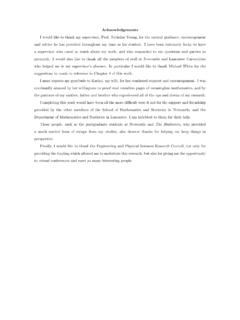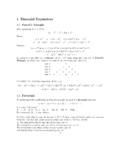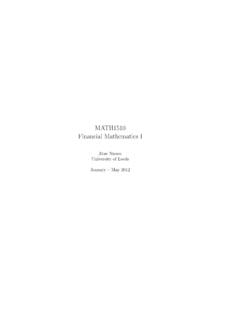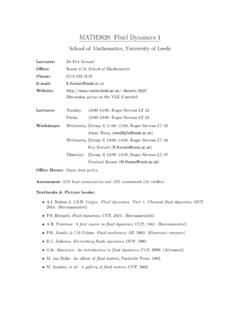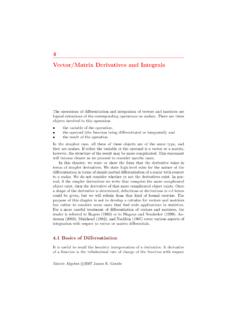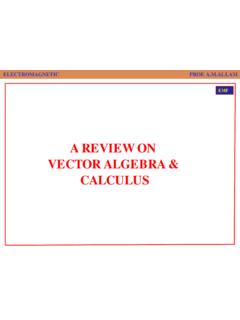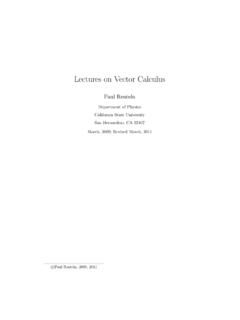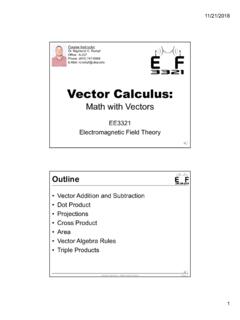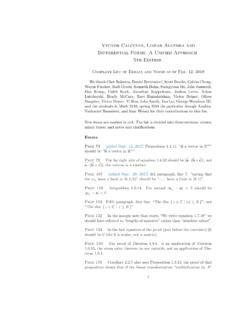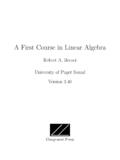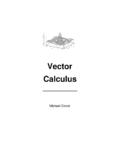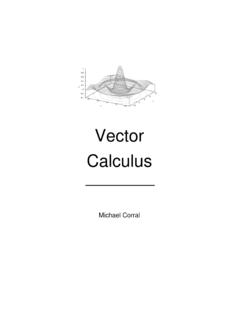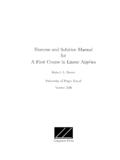Transcription of VECTOR CALCULUS: USEFUL STUFF Revision of Basic Vectors
1 Prof. TobiasJan 2009 VECTOR calculus : USEFUL STUFFR evision of Basic VectorsAscalaris a physical quantity with magnitude onlyAvectoris a physical quantity with magnitude and directionAunit vectorhas magnitude Cartesian coordinatesa=a1e1+a2e2+a3e3= (a1,a2,a3)Magnitude:|a|= a21+a22+a23 The position vectorr= (x,y,z)Thedot product(scalar product)a b=|a||b|cos =a1b1+a2b2+a3b3is a scalarThecross product( VECTOR product)a bis a VECTOR with magnitude|a||b|cos and a directionperpendicular to bothaandbin a right-handed b= (a2b3 a3b2)e1+ (a3b1 a1b3)e2+ (a1b2 a2b1)e3 Thescalar triple product[a,b,c] is a scalar[a,b,c] =a b c=a b c=b c aThevector triple productis a vectora (b c) = (a c)b (a b)cVector algebra and Suffix NotationThe rules of suffix notation.
2 (1) Any suffix may appearonceortwicein any term in an equation(2) A suffix that appears just once is called afree free suffices must be the same on both sides of the suffices take the values 1, 2 and 3(3) A suffix that appears twice is called adummy Convention: Dummy Suffices are summed over from1to3 The name of a dummy suffix is not b=ajbj=albl=apbp=a1b1+a2b2+a3b3(4) The Kronecker Delta: ij={1 ifi=j,0 ifi6=jor ij= 1 0 00 1 00 0 1 The Kronecker Delta issymmetric ij= jiand ijaj=ai(5) The Alternating Tensor: ijk= 0 if any ofi,jorkare equal,1 if (i,j,k) = (1,2,3), (2,3,1) or (3,1,2) 1 if (i,j,k) = (1,3,2), (3,2,1) or (2,1,3)The Alternating Tensor isantisymmetric: ijk= jikThe Alternating Tensor is invariant under cyclic permutations of the indices: ijk= jki= kij(6) The VECTOR product:(a b)i= ijkajbk(7) The relation between ijand ijk.}
3 Ijk klm= il jm im jlVector DifferentiationIn all of the below formulae we are considering the vectorF= (F1,F2,F3) Basic VECTOR Differentiation(1) IfF=F(t) thendFdt=(dF1dt,dF2dt,dF3dt)(2) The unit tangent to the curvex= (t) is given bydx/dt|dx/dt|Grad, Div and Curl(3) Thegradientof a scalar fieldf(x,y,z) (=f(x1,x2,x3)) is given bygradf= f=( f x, f y, f z)=( f x1, f x2, f x3)(4) fis the VECTOR field with a direction perpendicular to the isosurfaces offwith a magnitudeequal to the rate of change offin that direction.(5) Thedirectional derivativeoffin the direction of a unit VECTOR uis ( f) u(6) pronounceddelornablais avector differential operator. It is possible to study the algebraof.
4 (7) Thedivergenceof a VECTOR fieldFis given bydivF= F= F1 x+ F2 y+ F3 z= F1 x1+ F2 x2+ F3 x3(8) A VECTOR fieldFissolenoidalif F= 0 everywhere.(9) Thecurlof a VECTOR fieldFis given bycurlF= F=( F3 y F2 z)e1+( F1 z F3 x)e2+( F2 x F1 y)e3=( F3 x2 F2 x3)e1+( F1 x3 F3 x1)e2+( F2 x1 F1 x2)e3= e1e2e3 x y zF1F2F3 = e1e2e3 x1 x2 x3F1F2F3 (10) A VECTOR fieldFisirrotationalif F= 0 everywhere.(11) (F ) is a VECTOR differential operator which can act on a scalar or a VECTOR (F )f=F1 f x+F2 f y+F3 f z(F )G= ((F )G1,(F )G2,(F )G3)(12) TheLaplacianoperator 2= 2 x2+ 2 y2+ 2 z2can act on a scalar or a , Div and Curl and suffix notationIn suffix notationr= (x,y,z) =xigradf= ( f)i= f xi( )i= xidivF= F= Fj xj(curlF)i= ( F)i= ijk Fk xj(F ) =Fj xjNote.
5 Here you cannot move the xjaround as it acts on everything that follows can all be used to prove the VECTOR differential IdentitiesHere are some simple VECTOR identities that can all be proved with suffix VECTOR fields and and are scalar fields then ( ) = 2 ( F) = 0 ( ) =0 ( ) = + ( F) = F+F ( F) = F+ F ( F) = ( F) 2F (F G) =F ( G) +G ( F) + (F )G+ (G )F (F G) =G ( F) F ( G) (F G) =F( G) G( F) + (G )F (F )GVector Integral TheoremsAlternative Definitions of divergence and curl(1) An alternative definition ofdivergenceis given by F= lim V 01 V SF ndS,where Vis a small volume bounded by a surface Swhich has outward-pointing normaln.
6 (2) An alternative definition ofcurlis given byn F= lim S 01 S CF dr,where Sis a small open surface bounded by a curve Cwhich is oriented in a right-handed Interpretation of divergence and curl(3) The divergence of a VECTOR field gives a measure of how much expansion and contraction thereis in the field.(4) The curl of a VECTOR field gives a measure of how much rotation or twist there is in the Divergence and Stokes Theorems(5) Thedivergence theoremstates that V F= SF ndS,whereSis the closed surface enclosing the volumeVandnis the outward-pointing normal fromthe surface.(6)Stokes theoremstates that S F ndS= CF dr,whereCis the closed curve enclosing the open surfaceSandnis the normal from the VECTOR fields, line integrals and exact differentials(7) The following 5 statements are equivalent in a simply-connected domain:(i) F= 0 at each point in the domain.
7 (ii) CF dr= 0 around every closed curve in the region.(iii)Q PF dris independent of the path of integration fromPtoQ.(iv)F dris an exact differential.(v)F= for some scalar which is single-valued in the region.(8) If F= 0 thenF= Afor someA. (Thisvector potentialAis not unique.)

